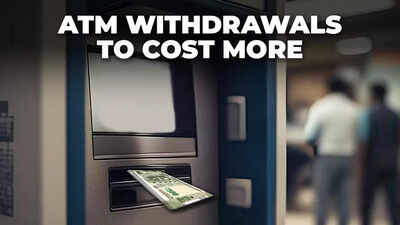- News
- Business News
- Financial Literacy News
- ATM withdrawals set to cost you more from May 1 - here’s why
Trending
ATM withdrawals set to cost you more from May 1 - here’s why
ATM withdrawals will become more expensive starting May 1, as the RBI and NPCI approve an increase in interchange fees. This move aims to sustain ATM operators' business viability. Cardholders in major cities will still have a limited number of free transactions available.
ATM withdrawals will cost more soon! The Reserve Bank of India (RBI) and the National Payments Corporation of India (NPCI) have sanctioned an increase of ₹2 in ATM interchange fees for cash withdrawals to ensure business sustainability. These revised charges will be effective from May 1.
This fee, charged between card-issuing and ATM-operating banks, ultimately affects customer banking expenses. Presently, account holders in Bengaluru, Chennai, Hyderabad, Kolkata, Mumbai, and New Delhi can make five free transactions monthly at their bank's ATMs and three at other banks' machines. Sources indicate the heightened interchange fee will impact customers, though banks currently cover free transaction costs. According to RBI statistics, India operated 2,16,706 ATMs as of January 2025.
The National Financial Switch Steering Committee endorsed an increase in ATM interchange fees on March 6, 2024, setting domestic financial transactions at ₹19 and non-financial transactions at ₹7. Subsequently, NPCI requested RBI's endorsement for implementing these adjustments.
Also Read | Mahila Samman Savings Certificate: Last few days left to get 7.5% interest for two years - top facts about post office savings scheme
As per the circular distributed to member banks, which ET has examined, NPCI has informed RBI about the implementation date of the revised fees.
"This fee hike provides additional support to banks and white-label ATM (WLA) operators, enabling them to maintain and enhance the ATM infrastructure," said Anush Raghavan, president—Cash Management Solution, CMS Info Systems. "We anticipate that the current fee adjustment will further incentivise banks to invest in and expand their ATM networks, thereby improving accessibility and convenience for customers nationwide."
A report in the financial daily last year indicated that ATM operators' association suggested raising the interchange fee to ₹23 for improved business viability. The interchange fee saw an increase from ₹15 to ₹17 in 2021, whilst the maximum customer transaction fee rose from ₹20 to ₹21.
Also Read | Are your bank deposits insured if bank fails? Up to Rs 5 lakh deposit insurance scheme explained
ATM usage has shown a consistent decline. RBI figures demonstrate a reduction in cash withdrawals from over 57 crore transactions in January 2023 to 52.72 crore in January 2024, further decreasing to 48.83 crore by January 2025. Nevertheless, cash remains crucial in India's economic landscape. The 2021 interchange fee increase contributed to ATM network growth. During FY24, monthly ATM withdrawals averaged ₹1.43 crore, showing a 5.51% annual increase. NPCI's correspondence specified a ₹7 interchange fee for balance enquiries in Nepal and Bhutan, excluding GST, whilst maintaining existing cash withdrawal rates. These revised fees exclude Micro-ATMs, interoperable cash deposits, and international ATM transactions.

About the Author
TOI Business DeskEnd of Article
FOLLOW US ON SOCIAL MEDIA
















